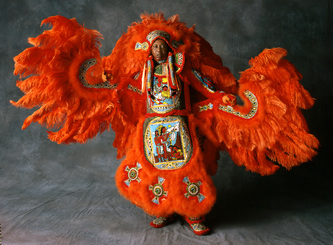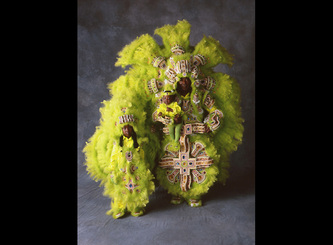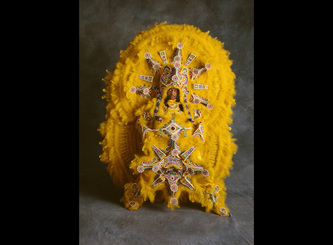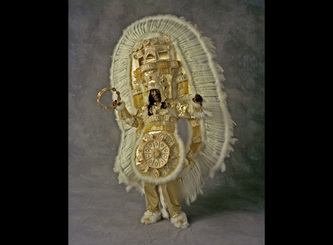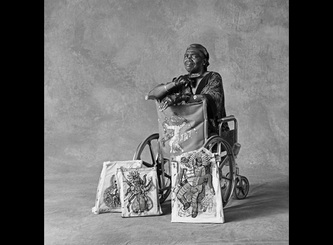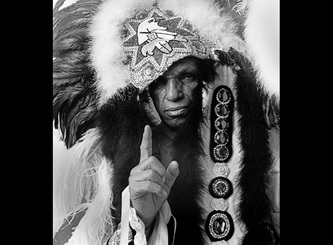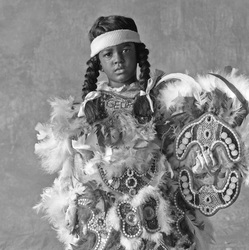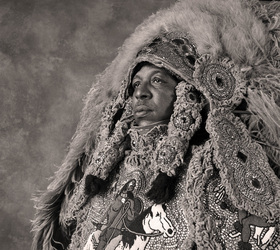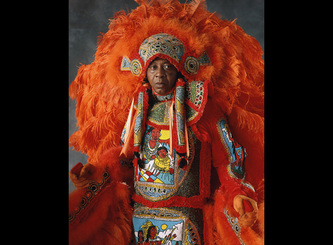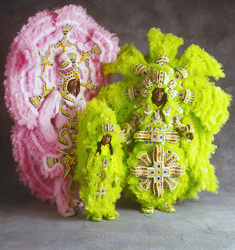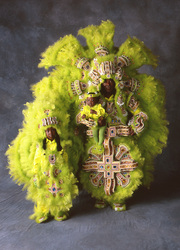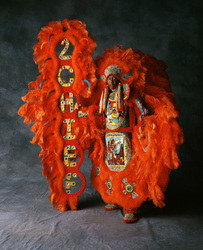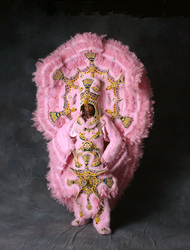GALLERY:
|
Mardi Gras Indian Studio - Flickr Archive
|
|
MARDI GRAS INDIAN STUDIO -Flickr archive
Please note on your order the specific titles of the imagery desired. Order prints by clicking on any thumbnail to get the large version and image title OR image #. |
THE BLACK INDIANS OF NEW ORLEANS: A PORTRAIT OF A THREATENED SUBCULTURE
In the midst of the computer age, when there is tremendous pressure to access information faster, cheaper and easier, we often lose sight of the traditions that make up our heritage. Gone are many of the arts we once cherished, now cast aside as old-fashioned and out-of-date. One tradition in New Orleans clings onto to its ancestral strength of handwork, persistence, pride and the yearly renewal of respectfulness to its origins... that of the Black Mardi Gras Indians.
The Black Mardi Gras Indians of New Orleans are a unique sub-culture of a highly diverse and complex local population group. The tradition of "masking Indian" may result from the need for celebration and self-expression among a disenfranchised people: the often very poor and, mostly socially deprived blacks living in urban New Orleans. The scholarship on the origins of the Mardi Gras Indians (over a hundred year old tradition) is conflicting and many theories abound. Mardi Gras is an integral part of New Orleans and the Mardi Gras Indians are interlinked into the celebration. In the heart of New Orleans since the 1880's and perhaps earlier, this ancient, colorful and artistic culture has been practiced. A culture that exhibits tradition, heritage and a unique history. A culture that has survived despite being forced underground by the "Jim Crow" laws of the 1890's. A tradition that keeps alive the memory of a two century bond between African-American and Native Americans. The affection of the African-American for the native American dates back to the 1780's when the slaves from every part of Africa had been transported to New Orleans. These slave would gather by the hundreds on Sunday afternoons to sing and dance in their traditional style at Congo Plains (now the site of Louis Armstrong Park). The Indians were villages outside of the Plains living along nearby bayous and encampments just outside the outskirts of town. It has told that tribes such as the Choctaw and Chickasaws in Louisiana were responsible for freeing African and men of color from slavery. Additional research underscores the fact that many of these runaways and freed men in fact intermarried with the tribes' members and strongly identifying with the Indians resistance against anglo subjugation and fought side by side with them. Both the Native Americans and the African slaves share a reverence for the spirits of their ancestors, a strong belief in the celebration of seasonal changes and the use of ritual costumes.
It is a West African tradition to signal respect for one's host by dressing like them at ritual celebrations. There is strong evidence that the costumes of modern day Mardi Gras Indians are a cross between Africa ritual costumes and that of the Native American. The long braided wig, reference to and wearing of the crowns, the beaded and feathered costumes, the use of moccasin-style footwear. A blending of two cultures have spawned a new, unique tradition.
Despite its highly unusual origin, its social marginality, and its general obscurity, the Mardi Gras Indian tradition has made a deep imprint on American popular culture. The ritual music of the Indian ‘practices,’ which occur all through the year, will be heard in much of the early ‘rhythm and blues’ and later ‘rock n roll’ recordings first made in New Orleans; pop music which set the stage for the global phenomenon of Rock. There is no moment in which some person, somewhere in the world, willing or otherwise, is not listening to a musical form directly traceable to the rhythmic chanting and beat of the Indians.
The Mardi Gras Indian nation is loosely organized into "tribes" which labor all year long in creating magnificent "suits" consisting of intricate hand beading and decoration, feathers and plumes, as well as symbolic accouterments like rifles, "sticks" (staffs), shields and tribal flags. On Mardi Gras day, each year "tribes" of black Indians parade through their own neighborhoods singing and dancing to traditional chants particularly unique to the Mardi Gras Indians. Participants, family members, neighbors and friends all find themselves immersed in the lore of the black Indians, their music and activities.... weekly "Indian practices" and to the sewing and beading of costumes-- brilliant spectacles made of colorful ostrich plumes, feathers, sequins, rhinestones ribbons and beads. Each suit represents many hundreds of hours of effort by the individual Indian and other helpers, and is worn only one season before it is broken down. This hand sewn suit contains specific parts. A vest usually covers the chest and back, and sometimes a dickey is worn around the neck. Under the arms are "wings" that open up when the arms are extended. One the wrists may be additional decorative "sleeves." Below the waist--both in the front and back--is a large apron, the lost often being the most elaborate. Designs are sketched on canvas "patches" and painstakingly beaded and "stoned" into the costume. Each patch or design tells a story and must be in harmony with the dominant color of the costume. The beaded patches which are the basis of many suits are works of art and worthy of preservation as a form of true indigenous folk art. The Indians keep the traditions alive through great personal sacrifice, as an Indian suit may cost many thousands of dollars. Through generations, the suits have become more elaborate. Each creation stands alone as a work of art. It is with a great deal of pride and pleasure that we salute the families of those African-American men, women, and children who make and wear the costumes.
Although each suit is a spectacular visual manifestation of the Black Mardi Gras Indian culture, it is by no means the sole method of expression. Individual members of the tribe exhibit extraordinary skills in confrontational posturing, music, singing and role playing. One by one, dancing in toe/heel fashion, each member of a tribe meets his counterpart. Spyboy first meets spyboy. Flagboy meets flagboy, Wildman, first, second , and third chiefs, queen(s) and children all meet and play out their traditional roles. And finally, one big chief faces another. Knees bent, arms outspread, swaying from foot to foot, and turning in a circular motion, the chiefs slowly size up each other. This preening proves especially effective for showing off the costumes. Prestige for the tribe is garnered through the beauty and intricacy of the suits, role playing and the strength of its presence in the community. This ritualize dance drawing both from the African and Native American heritage, occurs only when one tribe meets another. Since the tribes have no set routes for their day's "journeys" whether they meet each other or not is entirely a matter of chance. To witness this procession, it is the custom to wait- perhaps from dawn-outside the house of one of the big chiefs. Song lyrics are accompanied by "percussive instrument" ... the banging drums, cow bells and tambourines, are customarily "called" by the big chief. The tribe and its crowd of enthusiastic followers "respond" sometimes chanting a traditional chorus of words that have no common meaning and often derived from the early Creole language. These songs although similar are sung rarely-if ever- sung in just the same way by all the tribes, although they lay claim to the same repertoire. The tempo may be relaxed or fast, depending upon the mood of the singers, but it remains consistent throughout the song. Competition is nurtured Ian creative climate that awards prestige and respect to the person who is able to "out-sew", out-dress, out-sing" another Black Indian of equal rank from another tribe.
This culture, like so many other micro-ethnic cultures, is highly stressed and at worse, is in danger of passing out of existence. Young blacks in economically depressed New Orleans are hard-pressed to become Mardi Gras Indians and older members are beginning to retire leaving few to attempt the skill, patience, and sacrifice necessary to continue the tradition by passing it along to the next person. At best, the culture is succumbing to change brought about by the external pressures of the need to survive modern day commercial threats and the inability to resist conforming to society's demands for familiar sameness. To be an Indian is a very special calling. It means defying seemingly overwhelming forces and making a stand for individual power. That power is often exhibited in 'being pretty' and in 'playing Indian' well.
It is important to elaborate via historical investigation, interviews and illustrative portraits, a solid explanation of and a detailed commentary on, this unique cultural remnant; to make assessable to a wide public, the history and current characteristics of a collective subculture; its behavior and handicraft tradition that have survived isolation and exclusion from mainstream society for a century and a half. Ironically, it is this very hermetic environment, induced by historical marginality and poverty, that has preserved the Black Mardi Gras Indian tradition in its current form. For the record, a total picture of contemporary Indian life needs to be assembled, to see exactly where the crafting, costuming, parading and associated music fit into the overall social life of the participants. The purpose, then, is first of all, to document in the most detail possible, the Indian tradition in its fullest historical and current social and material context and secondarily to bring a wide attention in a proper way, to an extraordinary but vanishing phenomenon, which might only be preserved and continued with public and private support.
Many Indians have remarked that the dancing traditions, the ritual mock- warfare, and the craft of producing the costumes, have all changed dramatically in the past few decades. The formal etiquette that surrounded Indian street activities for at least a century, has lost much of its continuity and detail. It seems crucial to capture the impressions of older Indians as soon as possible, as cultural memory is often both fragile and unreliable. In fact it depends for its continuance upon the interplay of artisan, family, tribal alliance, and neighborhood. Though the performances are a display of individual charisma, authority, group leadership, and spiritual continuity with Indian and African ancestors, they work to reinforce the communal solidarity of old neighborhoods and collective groups bound by fictive kinship, territoriality, common history and the collective experience of centuries of oppression. The Indians have long survived with no support of any kind from the city itself. The fact that each artisan operates alone and conceals his creative production until the day of its debut, ought not beguile the observer into thinking that the Indian culture is a purely individualistic one.
The United States is festooned with large cities having marginal areas of impoverished underclass inhabitants who cycle through life known only to their immediate relatives. Though New Orleans also presents some of these pictures, there is more. The traditionally neglected and outcast classes of the New Orleans underground have for centuries responded with counter narratives, counter music and counter art forms of many kinds. That is, they have responded creatively to their condition. Louis Armstrong rose from lowly origins to revolutionize popular music and became New Orleans’ first world citizen. In the case of the Black Indians, we find a parallel creative response to like conditions. As there are many biographies of Armstrong, none actually identifies who he is. He remains a mystery. The Indians remain as much.
The Black Mardi Gras Indians of New Orleans are a unique sub-culture of a highly diverse and complex local population group. The tradition of "masking Indian" may result from the need for celebration and self-expression among a disenfranchised people: the often very poor and, mostly socially deprived blacks living in urban New Orleans. The scholarship on the origins of the Mardi Gras Indians (over a hundred year old tradition) is conflicting and many theories abound. Mardi Gras is an integral part of New Orleans and the Mardi Gras Indians are interlinked into the celebration. In the heart of New Orleans since the 1880's and perhaps earlier, this ancient, colorful and artistic culture has been practiced. A culture that exhibits tradition, heritage and a unique history. A culture that has survived despite being forced underground by the "Jim Crow" laws of the 1890's. A tradition that keeps alive the memory of a two century bond between African-American and Native Americans. The affection of the African-American for the native American dates back to the 1780's when the slaves from every part of Africa had been transported to New Orleans. These slave would gather by the hundreds on Sunday afternoons to sing and dance in their traditional style at Congo Plains (now the site of Louis Armstrong Park). The Indians were villages outside of the Plains living along nearby bayous and encampments just outside the outskirts of town. It has told that tribes such as the Choctaw and Chickasaws in Louisiana were responsible for freeing African and men of color from slavery. Additional research underscores the fact that many of these runaways and freed men in fact intermarried with the tribes' members and strongly identifying with the Indians resistance against anglo subjugation and fought side by side with them. Both the Native Americans and the African slaves share a reverence for the spirits of their ancestors, a strong belief in the celebration of seasonal changes and the use of ritual costumes.
It is a West African tradition to signal respect for one's host by dressing like them at ritual celebrations. There is strong evidence that the costumes of modern day Mardi Gras Indians are a cross between Africa ritual costumes and that of the Native American. The long braided wig, reference to and wearing of the crowns, the beaded and feathered costumes, the use of moccasin-style footwear. A blending of two cultures have spawned a new, unique tradition.
Despite its highly unusual origin, its social marginality, and its general obscurity, the Mardi Gras Indian tradition has made a deep imprint on American popular culture. The ritual music of the Indian ‘practices,’ which occur all through the year, will be heard in much of the early ‘rhythm and blues’ and later ‘rock n roll’ recordings first made in New Orleans; pop music which set the stage for the global phenomenon of Rock. There is no moment in which some person, somewhere in the world, willing or otherwise, is not listening to a musical form directly traceable to the rhythmic chanting and beat of the Indians.
The Mardi Gras Indian nation is loosely organized into "tribes" which labor all year long in creating magnificent "suits" consisting of intricate hand beading and decoration, feathers and plumes, as well as symbolic accouterments like rifles, "sticks" (staffs), shields and tribal flags. On Mardi Gras day, each year "tribes" of black Indians parade through their own neighborhoods singing and dancing to traditional chants particularly unique to the Mardi Gras Indians. Participants, family members, neighbors and friends all find themselves immersed in the lore of the black Indians, their music and activities.... weekly "Indian practices" and to the sewing and beading of costumes-- brilliant spectacles made of colorful ostrich plumes, feathers, sequins, rhinestones ribbons and beads. Each suit represents many hundreds of hours of effort by the individual Indian and other helpers, and is worn only one season before it is broken down. This hand sewn suit contains specific parts. A vest usually covers the chest and back, and sometimes a dickey is worn around the neck. Under the arms are "wings" that open up when the arms are extended. One the wrists may be additional decorative "sleeves." Below the waist--both in the front and back--is a large apron, the lost often being the most elaborate. Designs are sketched on canvas "patches" and painstakingly beaded and "stoned" into the costume. Each patch or design tells a story and must be in harmony with the dominant color of the costume. The beaded patches which are the basis of many suits are works of art and worthy of preservation as a form of true indigenous folk art. The Indians keep the traditions alive through great personal sacrifice, as an Indian suit may cost many thousands of dollars. Through generations, the suits have become more elaborate. Each creation stands alone as a work of art. It is with a great deal of pride and pleasure that we salute the families of those African-American men, women, and children who make and wear the costumes.
Although each suit is a spectacular visual manifestation of the Black Mardi Gras Indian culture, it is by no means the sole method of expression. Individual members of the tribe exhibit extraordinary skills in confrontational posturing, music, singing and role playing. One by one, dancing in toe/heel fashion, each member of a tribe meets his counterpart. Spyboy first meets spyboy. Flagboy meets flagboy, Wildman, first, second , and third chiefs, queen(s) and children all meet and play out their traditional roles. And finally, one big chief faces another. Knees bent, arms outspread, swaying from foot to foot, and turning in a circular motion, the chiefs slowly size up each other. This preening proves especially effective for showing off the costumes. Prestige for the tribe is garnered through the beauty and intricacy of the suits, role playing and the strength of its presence in the community. This ritualize dance drawing both from the African and Native American heritage, occurs only when one tribe meets another. Since the tribes have no set routes for their day's "journeys" whether they meet each other or not is entirely a matter of chance. To witness this procession, it is the custom to wait- perhaps from dawn-outside the house of one of the big chiefs. Song lyrics are accompanied by "percussive instrument" ... the banging drums, cow bells and tambourines, are customarily "called" by the big chief. The tribe and its crowd of enthusiastic followers "respond" sometimes chanting a traditional chorus of words that have no common meaning and often derived from the early Creole language. These songs although similar are sung rarely-if ever- sung in just the same way by all the tribes, although they lay claim to the same repertoire. The tempo may be relaxed or fast, depending upon the mood of the singers, but it remains consistent throughout the song. Competition is nurtured Ian creative climate that awards prestige and respect to the person who is able to "out-sew", out-dress, out-sing" another Black Indian of equal rank from another tribe.
This culture, like so many other micro-ethnic cultures, is highly stressed and at worse, is in danger of passing out of existence. Young blacks in economically depressed New Orleans are hard-pressed to become Mardi Gras Indians and older members are beginning to retire leaving few to attempt the skill, patience, and sacrifice necessary to continue the tradition by passing it along to the next person. At best, the culture is succumbing to change brought about by the external pressures of the need to survive modern day commercial threats and the inability to resist conforming to society's demands for familiar sameness. To be an Indian is a very special calling. It means defying seemingly overwhelming forces and making a stand for individual power. That power is often exhibited in 'being pretty' and in 'playing Indian' well.
It is important to elaborate via historical investigation, interviews and illustrative portraits, a solid explanation of and a detailed commentary on, this unique cultural remnant; to make assessable to a wide public, the history and current characteristics of a collective subculture; its behavior and handicraft tradition that have survived isolation and exclusion from mainstream society for a century and a half. Ironically, it is this very hermetic environment, induced by historical marginality and poverty, that has preserved the Black Mardi Gras Indian tradition in its current form. For the record, a total picture of contemporary Indian life needs to be assembled, to see exactly where the crafting, costuming, parading and associated music fit into the overall social life of the participants. The purpose, then, is first of all, to document in the most detail possible, the Indian tradition in its fullest historical and current social and material context and secondarily to bring a wide attention in a proper way, to an extraordinary but vanishing phenomenon, which might only be preserved and continued with public and private support.
Many Indians have remarked that the dancing traditions, the ritual mock- warfare, and the craft of producing the costumes, have all changed dramatically in the past few decades. The formal etiquette that surrounded Indian street activities for at least a century, has lost much of its continuity and detail. It seems crucial to capture the impressions of older Indians as soon as possible, as cultural memory is often both fragile and unreliable. In fact it depends for its continuance upon the interplay of artisan, family, tribal alliance, and neighborhood. Though the performances are a display of individual charisma, authority, group leadership, and spiritual continuity with Indian and African ancestors, they work to reinforce the communal solidarity of old neighborhoods and collective groups bound by fictive kinship, territoriality, common history and the collective experience of centuries of oppression. The Indians have long survived with no support of any kind from the city itself. The fact that each artisan operates alone and conceals his creative production until the day of its debut, ought not beguile the observer into thinking that the Indian culture is a purely individualistic one.
The United States is festooned with large cities having marginal areas of impoverished underclass inhabitants who cycle through life known only to their immediate relatives. Though New Orleans also presents some of these pictures, there is more. The traditionally neglected and outcast classes of the New Orleans underground have for centuries responded with counter narratives, counter music and counter art forms of many kinds. That is, they have responded creatively to their condition. Louis Armstrong rose from lowly origins to revolutionize popular music and became New Orleans’ first world citizen. In the case of the Black Indians, we find a parallel creative response to like conditions. As there are many biographies of Armstrong, none actually identifies who he is. He remains a mystery. The Indians remain as much.
LEGACY PRINTS
The Legacy Prints represent a curated selection of Porché West's 35-year career as a documentary and fine art photographer.
Each image is personally printed to order. Prints are a signed pigment print with archival inks and paper. (Image size varies depending on format.) Packaged with tubed board in archival sleeve. Shipped via FedEx Ground. Allow 14 days for delivery.
Open Edition - 17" x 22" Pigment archival prints. $250
24" x 30" Pigment archival prints $350
ABOUT DIGITAL PIGMENT PRINTS:
The term "pigment print" is used generally for any type of printed image that uses strictly pigments. Pigment printing processes have been utilized since the middle of the 19th century. The image stability of pigment printing is superior to that of any other method of printing, including traditional silver-halide or metal-based.
Digital inkjet printing has seen a surge in the use of the pigment ink as ink sets have been refined to be compatible with the latest in high-resolution inkjet technology. Where archival dye-based ink sets exhibit excellent color gamut, pigment inks excel in permanence. A dye is molecularly soluble in its vehicle, but pigment is not. Pigment particles tend to be large enough to embed into the receiving substrate making them water-resistant. The particulate nature of pigment inks ensures their archival superiority. A particle of pigment is less susceptible to destructive environmental elements than a dye molecule.
Considering the above factors, we define a digital pigment print, sometimes referred to as a pigmented paper print, as a digital image rendered onto an coated, natural fiber substrate with pigment inks. The quality of the giclee print rivals traditional silver-halide and gelatin printing processes and is commonly found in museums, art galleries, and photographic galleries.
The Legacy Prints represent a curated selection of Porché West's 35-year career as a documentary and fine art photographer.
Each image is personally printed to order. Prints are a signed pigment print with archival inks and paper. (Image size varies depending on format.) Packaged with tubed board in archival sleeve. Shipped via FedEx Ground. Allow 14 days for delivery.
Open Edition - 17" x 22" Pigment archival prints. $250
24" x 30" Pigment archival prints $350
ABOUT DIGITAL PIGMENT PRINTS:
The term "pigment print" is used generally for any type of printed image that uses strictly pigments. Pigment printing processes have been utilized since the middle of the 19th century. The image stability of pigment printing is superior to that of any other method of printing, including traditional silver-halide or metal-based.
Digital inkjet printing has seen a surge in the use of the pigment ink as ink sets have been refined to be compatible with the latest in high-resolution inkjet technology. Where archival dye-based ink sets exhibit excellent color gamut, pigment inks excel in permanence. A dye is molecularly soluble in its vehicle, but pigment is not. Pigment particles tend to be large enough to embed into the receiving substrate making them water-resistant. The particulate nature of pigment inks ensures their archival superiority. A particle of pigment is less susceptible to destructive environmental elements than a dye molecule.
Considering the above factors, we define a digital pigment print, sometimes referred to as a pigmented paper print, as a digital image rendered onto an coated, natural fiber substrate with pigment inks. The quality of the giclee print rivals traditional silver-halide and gelatin printing processes and is commonly found in museums, art galleries, and photographic galleries.



